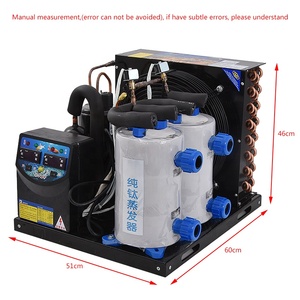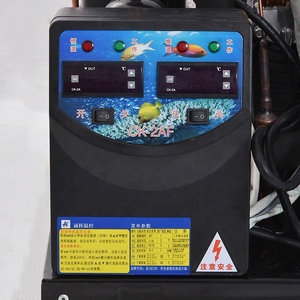(7450 products available)

















































































































































































































A seafood chiller is an essential piece of equipment used in the seafood industry to preserve the quality of fish and other seafood items. The following are some common types of seafood chillers:
They are often used to cool fresh fish and maintain an optimal storage temperature. In air chillers, cold air is circulated around the products to absorb heat and lower temperatures. Then, the fish can be stored in refrigerated rooms or display cases. What's more, the air chillers can offer a consistent temperature throughout the storage area, which is especially suitable for large warehouses or distribution centers.
Blast chillers can rapidly lower the temperature of seafood items by blowing chilled air over them. This process can help to quickly freeze seafood products, thus preserving their quality and taste. Blast chillers are usually used to freeze fish fillets, shrimp, and other quick-frozen seafood items, and they are ideal for commercial kitchens and food processing facilities. In addition, the rapid cooling feature of blast chillers helps to minimize the growth of bacteria and reduce the risk of food contamination.
This seafood chiller is designed to use ice slurry to cool and maintain the temperature of fish and seafood products. Ice slurry is a mixture of ice crystals and liquid, which can provide rapid and uniform cooling. Ice slurry chillers are often used in high-end seafood markets, fish processing plants, and distribution centers. This is because they can help maintain the quality and freshness of seafood products. In the process of using ice slurry chillers, the products are often placed in a container filled with ice slurry for cooling. The combination of liquid and solid ice can ensure gentle and efficient cooling without damaging the delicate texture of the seafood.
Plate chillers are also known as ice water chillers. They are devices that use cold plates to cool and preserve seafood products. The cold plates are made of metal with integrated refrigerant channels. Plate chillers can be used in seafood processing facilities, fish markets, and restaurants. Also, they are great for keeping fish fillets, shellfish, and other seafood items fresh. In addition, the plate chillers can provide rapid and even cooling. They can also maintain a precise temperature, thus helping to preserve the quality of seafood products.
Seafood chillers are designed to meet various needs and maintain their performance over time through proper maintenance.
Temperature range: Seafood chillers are designed to maintain specific ranges of temperature. The temperature range of the chiller is often between 0-10 degrees Celsius, allowing the storage of seafood at the right temperature to preserve its quality.
Capacity: Seafood chillers are available in a variety of capacities to meet the demands of different businesses. The capacity of the chiller may range from a few kilograms to several hundred kilograms, depending on the size of the unit.
Construction material: Commercial seafood chillers are often constructed with stainless steel. The material used for the construction of the chiller is typically corrosion-resistant and easy to clean, ensuring it can withstand the harsh environment of the seafood industry and can be cleaned regularly.
Moisture control: Seafood items are perishable. They require a specific moisture level to maintain their quality. Seafood chillers are designed to maintain the right humidity levels. Moisture control systems like drain pans, dehumidifiers, and humidity sensors are often integrated into the seafood chillers to help regulate humidity and prevent the buildup of moisture.
Energy efficiency: Energy costs are a significant concern for many businesses. Select manufacturers that design seafood chillers that are energy efficient. Energy-efficient models of seafood chillers use different energy-saving technologies, such as high-efficiency compressors, well-insulated cabinets, and automatic energy-saving modes, to reduce energy consumption and lower operating costs.
Regular cleaning: This is the most important maintenance task for seafood chillers. Business owners should schedule regular cleaning of the chillers to prevent the buildup of mold, bacteria, and other contaminants. They should use appropriate cleaning solutions and disinfectants to clean the interior and exterior surfaces of the chillers thoroughly.
Condenser and evaporator coil cleaning: Condenser and evaporator coils are essential components of seafood chillers that are responsible for heat exchange and temperature control. They often accumulate dust, dirt, and debris, which can reduce the efficiency of heat exchange and cause the chiller to overheat. Therefore, regular cleaning of the coils should be done to ensure proper airflow and heat transfer.
Temperature and humidity sensor calibration: The accuracy of the sensors is crucial to maintaining the ideal temperature and humidity levels within the seafood chiller. Business owners should regularly calibrate the sensors to ensure they are functioning accurately. This can be done using temperature and humidity calibration kits or by hiring a professional technician.
Check and replace seals: The door seals of seafood chillers are essential to maintaining proper insulation and preventing air leaks. Business owners should regularly inspect the seals for signs of wear, damage, or looseness, and replace them promptly if any issues are found.
Professional maintenance: In addition to routine maintenance, it is important for business owners to schedule professional maintenance on a regular basis. This can help identify potential problems and address them early before they escalate into major issues.
Seafood is a highly perishable product that needs to be properly kept fresh throughout the supply chain. Seafood chillers play a crucial role in ensuring that seafood is safely kept fresh from the point of harvest to the final consumer. Here are some of the scenarios where seafood chillers are used.
After harvesting, seafood is usually taken to processing centers and fishmonger shops. Here, seafood chillers are used to maintain optimal temperature and humidity, ensuring that the seafood remains fresh and safe.
Seafood is popular in restaurants and food service establishments. Seafood chillers are used in these settings to store products before preparation and serving to customers. Storing seafood at the right temperature will help to maintain quality and taste of the products. Besides, it also helps to ensure that the products are safe for consumption.
Supermarkets and retail stores sell different types of seafood, including fish and shrimp. Seafood chillers are used in these stores to display products to customers. Keeping seafood products in chillers ensures that they remain fresh and appealing, thus increasing sales.
Delivery of frozen seafood is an important part of the supply chain. Seafood chillers are used in delivery trucks to maintain the required low temperatures while in transit. The chillers help to prevent thawing and ensure that the products reach the final destination while still in good condition.
Seafood markets and fishmonger stalls deal with different products like lobster and shellfish. Chillers are used to store live seafood products. They help to maintain the right temperature and humidity, mimicking the natural habitat of the seafood products. This helps to keep them alive and fresh until they are purchased by the customer.
Hotels and catering services may use seafood as an ingredient in their dishes. Seafood chillers are used to store different types of seafood products. Storing seafood products before preparation ensures that the ingredients are fresh and of good quality.
While not common, some people may use seafood chillers in their homes. The chillers may be used by people who need to store large quantities of seafood products for gatherings and special occasions.
The following tips can help business buyers choose the right seafood chiller for their customers:
Business buyers should determine the specific needs of their customers before investing in a seafood chiller. They should consider the types of seafood their customers stock and the quantities they usually store. Also, they should consider the customers' space requirements and the frequency at which they restock seafood. Understanding these needs will help business buyers invest in chillers that meet their customers' requirements.
Business buyers should opt for seafood chillers with precise temperature control features. They should choose chillers that have digital thermostats, which allow for accurate temperature settings. Also, they should consider chillers that offer different temperature zones to accommodate various types of seafood. Opting for chillers with temperature alarms is also a good idea. Such chillers will alert users when the temperature goes beyond the set range.
Business buyers should consider seafood chillers with energy-efficient features. They should opt for models with good insulation, high-quality door seals, and double-pane glass. Such features help to minimize temperature loss and reduce the workload of the chiller’s refrigeration system. Also, they should consider chillers with LED lighting, which consume less energy than incandescent bulbs.
Business buyers should choose seafood chillers made with materials that are resistant to corrosion and rust. Investing in such chillers will ensure they can withstand the moist environment of seafood storage. Also, they should choose chillers with antibacterial coatings on the interior surfaces. Such coatings help to prevent the growth of mold and bacteria. Additionally, business buyers should opt for chillers with removable gaskets and shelves for easy cleaning and maintenance.
Business buyers should check the reviews of the manufacturer and model they are interested in. Customers' feedback will provide insight into the performance, quality, and reliability of the chiller. Also, they should consider the general rating and the number of reviews. A chiller with multiple positive reviews is likely to be reliable.
Q1 What is the role of a blast chiller in the food industry?
In the food industry, blast chillers play a critical role in preserving food items. They do it by rapidly freezing them. By doing so, they reduce the growth of bacteria in the food, which in turn extends its shelf life. Also, blast chillers maintain the quality and texture of the food after it has been frozen.
Q2 What is the difference between a blast chiller and a freezer?
Both blast chillers and freezers are used to reduce the temperature of food items. However, the main difference between them is the speed and method of cooling. Blast chillers cool food items rapidly, while freezers cool them slowly over time.
Q3 What are the benefits of using a blast chiller?
Blast chillers have multiple benefits. They include preserving food safety by reducing the risk of bacterial growth. Blast chillers also help to maintain food quality by preserving the nutritional value and freshness of the food items being cooled. Blast chillers also help to increase efficiency in commercial kitchens by enabling chefs to prepare food in advance.
Q4 How long does it take a blast chiller to cool?
The time it takes a blast chiller to cool depends on the model and specifications. However, most standard models can cool food items to about 37 degrees Fahrenheit within 90 minutes or less. More powerful models can achieve even faster cooling times.
Q5 Are blast chillers worth it?
Yes, blast chillers are worth it. They are worth the investment, especially for businesses that deal with large quantities of food items that need to be preserved. They can quickly cool large volumes of food and reduce the risk of foodborne illnesses.